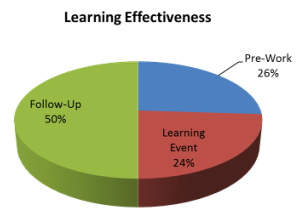ATD Blog
Why Management Training Is a Waste of Money
Mon Jan 12 2015

Bookmark

You have a problem. You know that your management team isn’t as effective as it could be, and you know that this problem comes down to a lack of skills or ineffective mindsets. So the solution is, of course, to find a management training professional to come in for a one- or two-day overhaul that will transform your managers into leadership rock stars.
Right? Not exactly.
Some $60-$80 Billion in the United States alone is spent annually toward leadership training. Yet only 20 percent to 30 percent of skills learned during this training actually results in on-the-job changes.
So if 4 out of 5 dollars spent on management training are wasted, why do we keep spending the money? Because our need for making our managers better leaders far outweighs the ineffectiveness of the training.
Is management training destined to fail, or are there adjustments that can be made to beat the averages and create a management program that is more effective? To answer this question, let’s look at why management training is failing in the first place.
No Focus on What Happens Before Training
When training occurs, participants are typically shuffled into a classroom with less than a basic idea of what to expect. Maybe they know that they’re going in to learn “how to delegate more effectively,” or “how to better influence others,” but research says that’s not enough.
According to a study by University of Phoenix, 26 percent of learning effectiveness is actually dependent on what happens before training even takes place. This period of time is also known as the “pre-event.” The purpose of focusing on what happens before training is to provide participants with an effective mindset before entering the actual training curriculum.
Little to No Follow-Up
We’re seeing more and more evidence that what happens after training is most influential on whether or not training sticks. For instance, according to a recent ATD study, 70 percent of training failures occur because the real-world application environment is not conducive to fostering retention and follow-through.
Without having accountability and regular refreshers on goals and priorities, the training curriculum will be quickly forgotten.
Management training is a waste of money. The exceptions have less to do with content (actually, most content in management training courses is generally quite similar), and more to do with what happens before and after training.
At Leadership Choice, we’ve dedicated our programs to overcoming the “how” and “why” of ineffective management training courses. In doing so, we have perfected a training platform that is 3x more effective than traditional leadership learning programs. Through some mindful changes to a traditional training system, we’ve been able to accomplish an average 85 percent retention and application rate.
We payi attention before training even starts. Our pre-event typically begins with a collaboration between a participant, their senior manager, and one of our leadership coaches. During this conversation, we are able to focus on a participants’ specific goals and needs. This gives the participant a preliminary mindset of what to focus on during training (instead of simply trying to be a “catch-all” for every bit of information) in order to more specifically fill their personal skill-gaps.
We prepare each participant to learn more effectively. Every participant in our program takes part in a communication workshop that helps them better understand their personal communication and learning patterns, as well as the communication patterns of those around them. Because management is such a people-oriented position, understanding how oneself and others communicate amplifies the success of the changes a manager will learn to make during their training program.
No participant flies alone. Our training models usually consist of four to five learning modules, each of which is directly followed by a one-on-one conversation with a personal leadership coach. This conversation personalizes the curriculum for each participant, allowing the participant along with their personal leadership coach to develop application plans and goals in order to make retention and application easier.
No goal is forgotten. While many participants in traditional management training programs may leave their training session with a list of goals and priorities, this list is typically forgotten within a matter of days. To mitigate forgotten applications, our personal leadership coaches meet with each participant’s supervisor post-training.
More importantly, Leadership Choice empowers the supervisors with the tools, knowledge, and follow-up to foster an environment in which the participant can successfully apply new behaviors.
More from ATD

